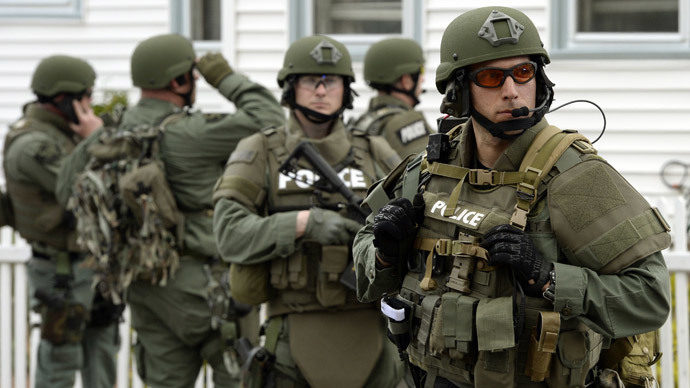Inheriting both the weapons and the mindset of the US military, police are becoming militarized and ‘hyper aggressive’ in their approach to maintaining security on the streets of America. New study calls on police not to treat people as ‘wartime enemies’.
The tragic story of Jose Guerena, 26, who served as a Marine in
the Iraq War, only to be killed by ‘friendly fire’ at his home in
Tucson, Arizona, is becoming a disturbingly familiar one across
the country.
On the morning of May 5, 2011, Guerena’s wife alerted him when
she heard strange sounds and the silhouette of a man standing
outside their home. Guerena got his wife and child into a closet,
grabbed his rifle, and went to investigate. This proved to be a
deadly mistake. A SWAT team opened fire on Guerena, who died on
his kitchen floor with multiple wounds and without medical
attention.

As it later emerged, the SWAT unit raided a number of residences in the neighborhood, turning up nothing more than a small bag of marijuana. No drugs were found in the Guerenas’ home.
Created in the late 1960s as “quasi-militaristic” units designed to handle emergency situations such as riots, hostage scenarios, and active shooter situations, the number of SWAT squads have since surged, and are “used with greater frequency and, increasingly, for purposes for which they were not originally intended—overwhelmingly to serve search warrants in drug investigations,” according to an ACLU report, entitled ‘War Comes Home: The Excessive Militarization of American Policing.’
The report examines 818 SWAT operations from July 2010 to last October, which were conducted by more than 20 law enforcement agencies in 11 states.
Today, paramilitary squads are better equipped to fight terrorists in foreign lands than serve and protect US civilians at home, and are becoming a dark chapter to America’s newfound capacity for “needless violence” and treating its citizens like “wartime enemies,” it said.
The 98-page document details the militarization of state and local law enforcement agencies, courtesy of expensive federal programs, which are dispensing “weapons and tactics of war, with almost no public discussion or oversight.” Although explicitly aimed at fighting drugs, the strategy is backfiring, sowing fear and discord among citizens, many of whom are starting to fear police as much as criminals.
As the United States winds down its military operations in Afghanistan and Iraq, local police forces are getting the used ‘hand-me-downs’ from the US military. This makes some American communities resemble the latest occupied zones with police dressed in combat fatigues and driving MRAPs and carrying AR-15s down Main Street.
“Using these federal funds, state and local law enforcement agencies have amassed military arsenals purportedly to wage the failed War on Drugs…But these arsenals are by no means free of cost for communities. Instead, the use of hyper aggressive tools and tactics results in tragedy for civilians and police officers, escalates the risk of needless violence, destroys property, and undermines individual liberties,” according to the report.
One bit of curious hardware being distributed to local police forces from the government’s military closet is the MRAP (Mine Resistant Ambush Protected) vehicle, which gives troops protection from improvised explosive devices (IEDs). Using media sources, ACLU put the number of towns that now possess the armored carriers at around 500. Among the lucky recipients, Dallas, Texas, has one, as does Salinas, California and even the Utah Highway Patrol.
The report noted that even Ohio State University Police owns one of the MRAPs in order to give a sense of “presence” on big football game days.
The results of the report revealed a worrying trend: “If the federal government gives the police a huge cache of military-style weaponry, they are highly likely to use it, even if they do not really need to.”
Case in point: Gwinnett County, Georgia, which received at least 57 semi-automatic rifles, mostly M-16s and M-14s. One-third of the county’s SWAT deployments dealt with drug investigations; in half of them, the SWAT team broke down the door to get inside, “and there was no record in any of the reports that weapons were found.”
Other examples were provided in Concord, Keene, and Manchester, quaint New Hampshire towns in close proximity to each other, yet each took advantage of DHS grants to buy the military-grade armored BearCat (the amount of grants received by these agencies ranged from $215,000 to $286,000). Justifications for the need to acquire such vehicles pointed to weapons of mass destruction and the threat of terrorism.
The Keene police department, for example, cites in its application (which trumps Ohio State University’s need for armored vehicles to provide “presence” at big football games), the annual pumpkin festival as a potential terrorism target that requires the assistance of an APC.
Military-style mentality invades police
Another leftover from America’s military adventures abroad is the peculiar military mindset that allows US personnel to survive in hostile lands. Equally unsettling as spotting armored vehicles winding through the tree-lined streets of otherwise quiet American neighborhoods is the spectacle of local police officers receiving military-style combat training.
The US Department of Justice described the boot-camp conditions being used to train new police recruits.
According to a Bureau of Justice Report, “the majority of police recruits receive their training in academies with a stress-based military orientation. This begs the question: is this military model—designed to prepare young recruits for combat—the appropriate mechanism for teaching our police trainees how to garner community trust and partner with citizens to solve crime and public order problems?”
As a result, a so-called “warrior” mentality inside
local police forces is “pervasive and extends well beyond
hostage situations and school shootings, seeping into officers’
everyday interactions with their communities,” the report
said.
The report describes a PowerPoint presentation that was delivered
to Cary, North Carolina, SWAT team members entitled “Warrior
Mindset/Chemical Munitions” for all Emergency Response Team
personnel.
The National Tactical Officers Association (according to its website, the NTOA “strives to provide our members with the tools they need to protect an increasingly dangerous society”) urges trainees to “Steel Your Battlemind” and defines “battlemind” as “a warrior’s inner strength to face fear and adversity during combat with courage. It is the will to persevere and win. It is resilience.”
The question, however, is whether such an approach to policing is conducive to creating peace on the streets of America? An escalation of police operations going awry are growing cause for concern among civil rights groups.
In early June, for example, a toddler was severely burned and left unable to breathe on his own when a Georgia SWAT team tossed a flashbang grenade in his crib during a drug raid - over a single meth sale of $50. Bounkham “Bou Bou” Phonesavanh, a 19-month-old, was asleep in his portable crib in the same room as his parents and three older sisters, when police opened the door to the converted garage and threw the stun grenade in.
In the ACLU’s study, SWAT units forced entry into a person’s home using a battering ram or other breaching device in 65 percent of drug searches.
As the report emphasizes, the training documents do not suggest that SWAT teams “should constrain their soldier-like tactics to terrorism situations.” Moreover, the majority of SWAT raids examined for the report “took place in the context of serving search warrants at people’s homes—not in response to school shootings or bombings.”
'It's a war zone in the US' - Interview with Indiana sheriff
The survey discovered that 62 percent of SWAT missions were for drug searches. Some 79 percent involved raids on private homes, and a similar proportion were carried out with warrants authorizing searches. However, just 7 percent of the incidents fell into those categories for which SWAT was originally designed to handle, such as hostage situations or shootings.
It is this type of military mindset, compounded with excessive firepower, which is turning many American communities into veritable tinderboxes, which only requires the slightest provocation to spiral into senseless violence and death.
The survey, which provided a small picture of the overall trend, reported seven cases where civilians died in connection with the deployment of SWAT units, two of which appeared to be suicides. Another 46 individuals were injured, often as the result of physical force by officers.

